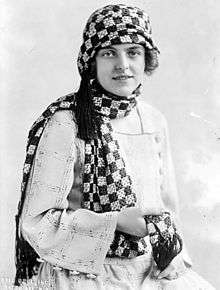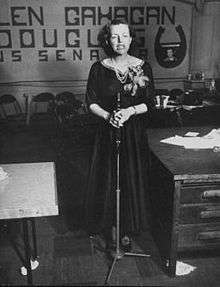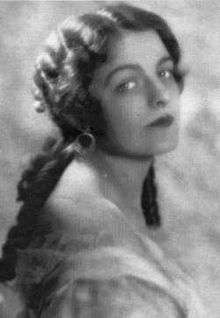Helen Gahagan Douglas
| Helen Gahagan Douglas | |
|---|---|
 | |
| Member of the U.S. House of Representatives from California's 14th district | |
|
In office January 3, 1945 – January 3, 1951 | |
| Preceded by | Thomas Ford |
| Succeeded by | Sam Yorty |
| Personal details | |
| Born |
Helen Gahagan November 25, 1900 Boonton, New Jersey, U.S. |
| Died |
June 28, 1980 (aged 79) New York City, New York, U.S. |
| Political party | Democratic |
| Spouse(s) | |
| Children | 2 |
| Education | Columbia University |
Helen Gahagan Douglas (November 25, 1900 – June 28, 1980) was an American actress and politician. Her career included success on Broadway, as a touring opera singer, and the starring role in the 1935 movie She, in which her portrayal of the villain inspired Disney's Evil Queen in Snow White and the Seven Dwarfs (1937).
She married actor Melvyn Douglas, to whom she remained married for life.
In politics, she was the third woman and first Democratic woman elected to Congress from California; her election made California one of the first two states (along with Illinois) to elect female members to the House from both parties. Her defeat as a candidate for the United States Senate in 1950 by Republican Richard Nixon, against whom she campaigned in his later presidential bids, became symbolic of modern political vitriol, with Nixon referring to her as "pink" down to her undergarments.
Early life
Gahagan was born in Boonton, New Jersey,[1] of Scotch-Irish descent.[2] She was the eldest daughter of Lillian Rose (Mussen) and Walter H. Gahagan, an engineer who owned a construction business in Brooklyn and a shipyard in Arverne, Queens; her mother had been a schoolteacher.[1] She was reared Episcopalian.[3][4] Gahagan was raised at 231 Lincoln Place[5] in the Park Slope area of Brooklyn, an upper-middle-class neighborhood, and graduated from the prestigious Berkeley School for Girls.[6] Following an argument with her father, who did not believe becoming an actress was a suitable future for a woman, Gahagan was sent to study at the Capen School for Girls in Northampton, Massachusetts.[5]
Gaghan gained admittance to Barnard College of Columbia University. To the dismay of her father, she left after two years (without finishing her degree) to pursue a career as an actress.[6]
Acting career

Gahagan found great success and became a well-known star on Broadway in the 1920s, appearing in popular plays such as Young Woodley and Trelawney of the Wells.[7]
In 1927, at the age of 26, Gahagan set out to forge a new career as an opera singer, and after two years of voice lessons, she found herself touring across Europe and receiving critical praise, unusual for an American at the time.[5] In 1930, she returned to Broadway to star in a production of Tonight or Never, where she co-starred with actor Melvyn Douglas. The two married in 1931, Gahagan keeping her maiden name.[5]
Gahagan Douglas went to Los Angeles in 1935, starring in the Hollywood movie, She, playing Hash-a-Motep, queen of a lost city. The movie, based on H. Rider Haggard's novel of the same name, is perhaps best known for popularizing a phrase from the novel, "She who must be obeyed." Gahagan's depiction of the "ageless ice goddess"[8] served as inspiration for the Evil Queen in Walt Disney's Snow White and the Seven Dwarfs.[9][10]
While in Vienna in 1938, performing Tosca at the Vienna State Opera, a dream come true for Gahagan Douglas, she found herself having coffee with a Nazi sympathizer. The experience sickened her to such a degree that she immediately flew back to Los Angeles, determined to strike out Nazism.[11]
Political career
Gahagan Douglas entered politics in the late 1930s but would remain a touchstone for decades later. She was mentioned in the 1965 song "George Murphy" by satirist Tom Lehrer. The song begins, "Hollywood's often tried to mix / show business with politics / from Helen Gahagan / to Ronald Reagan ..."
She largely disliked the atmosphere of Hollywood, and following the birth of her daughter, Mary Helen, in 1938, Gahagan Douglas took to learning about the plight of the migrant workers and grew increasingly politically aware.[7] She soon became the head of the John Steinbeck Committee, named for the author of The Grapes of Wrath and by 1940, she was the national spokesperson for migrants.[3]
Appointments and activities
First introduced to politics through her husband, the Douglases then joined the Hollywood Anti-Nazi League and called for a United States boycott against goods produced in Nazi Germany.[5] Gahagan Douglas joined the Democratic Party shortly after the election of Franklin D. Roosevelt in 1933. The Roosevelts and the Douglases would develop a close friendship, with Eleanor Roosevelt serving as a political mentor to Gahagan Douglas.
Gahagan Douglas was member of the national advisory committee of the Works Progress Administration and of the State committee of the National Youth Administration in 1939 and 1940. She then served as Democratic National committeewoman for California and vice chairwoman of the Democratic State central committee and chairman of the women's division from 1940 to 1944. She was also a member of the board of governors of the California Housing and Planning Association in 1942 and 1943, and was appointed by Roosevelt as a member of the Voluntary Participation Committee, Office of Civilian Defense. She would be appointed by President Harry S. Truman as an alternate United States Delegate to the United Nations Assembly.[12]
House of Representatives
Gahagan Douglas was elected to the United States House of Representatives from California's 14th congressional district as a Democrat in 1944, and she served in the Seventy-ninth, Eightieth, and Eighty-first Congresses (January 3, 1945 – January 3, 1951).[13] Her love affair with Lyndon B. Johnson was an open secret on Capitol Hill.[14]


1950 campaign for U.S. Senate
In 1950, Gahagan Douglas ran for the United States Senate even though incumbent Democrat Sheridan Downey was seeking a third term. California Democratic state chairman William M. Malone had advised Douglas to wait until 1952 to run for the Senate rather than split the party in a fight with Downey. Gahagan Douglas, however, told Malone that Downey had neglected veterans and small growers and must be unseated. Downey withdrew from the race in the primary campaign and supported a third candidate, Manchester Boddy, the owner and publisher of the Los Angeles Daily News. When Gahagan Douglas defeated Boddy for the nomination, Downey endorsed the Republican U.S. Representative Richard M. Nixon.[15]
Fellow Representative John F. Kennedy quietly donated money to Nixon's campaign against Gahagan Douglas, the two sharing similar views on the threat of communism.[16][17]
In the primary race, Boddy had referred to Gahagan Douglas as "the Pink Lady" and said that she was "pink right down to her underwear," a suggestion that she sympathized with the Soviet Union. During the general election, Nixon reprised this line of attack. His campaign manager, Murray Chotiner, had 500,000 flyers printed on sheets of pink paper. Chotiner explained, "The purpose of an election is not to defeat your opponent, but to destroy him." [18]
In a race that was remembered as one of the most vicious in California political history, Nixon's charges were intentionally directed towards the character assassination of Gahagan Douglas.[18] Nixon implied that she was a Communist "fellow traveler" by comparing her votes to those of the far-left, pro-Soviet Representative Vito Marcantonio, and deployed anti-Semitic surrogates to call on voters to reject her because her husband, Melvyn, was Jewish.[18] Gahagan Douglas, in return, popularized a nickname for Nixon which became one of the most enduring nicknames in American politics: "Tricky Dick."
Nixon won the election with more than 59% of the vote, and Gahagan Douglas's political career came to an end, but she remained an activist, continuing to advocate for the regulation of nuclear weapons for several decades. In the 1950 election, conservative Democrat Samuel W. Yorty (later a Republican convert) succeeded her in Congress.
Douglas would later say that Nixon's harsh campaign tactics were "completely unnecessary" and that she was probably going to lose the election anyway. Young, Republican-inclined voters in the state could feel a closer personal connection to Nixon, a 30-something man with a young family much like themselves, and perceived her as too liberal and stuck in the New Deal era. In addition, money from oil companies was pouring into the state to tilt the balance in favor of Nixon.
Later life
It was rumored that Douglas would be given a political appointment in the Truman administration but that the Nixon-Douglas race had made such an appointment too controversial for Truman.[19] According to Democratic National Committee vice-chair India Edwards, a Douglas supporter, Douglas could not have been appointed dogcatcher.[20]
In 1952, she returned to acting, and she later campaigned for John F. Kennedy, who ran successfully against Nixon, in the 1960 presidential race.[19] Kennedy's successor, Lyndon Johnson, appointed her to be "Special Ambassador" to the inauguration of Liberian President William Tubman[21] However, Douglas's subsequent opposition to the Vietnam War angered Johnson, estranging him from her.[22] She also campaigned for George McGovern in his unsuccessful bid to prevent Nixon's 1972 re-election, and she called for Nixon's ouster from office during the Watergate scandal.[23]

During and after the Watergate scandal, bumper stickers reading, "Don't blame me, I voted for Helen Gahagan Douglas" cropped up on cars in California.[24] At its 1979 commencement ceremonies, Barnard College awarded Gahagan Douglas its highest honor, the Barnard Medal of Distinction. She died the next year from breast and lung cancer, with her husband, Melvyn, by her side.[7]
Legacy
Senator Alan Cranston of California eulogized her on the floor of the Senate, on August 5, 1980, saying: "I believe Helen Gahagan Douglas was one of the grandest, most eloquent, deepest thinking people we have had in American politics. She stands among the best of our 20th century leaders, rivaling even Eleanor Roosevelt in stature, compassion and simple greatness."[25]
A collection of Helen Gahagan Douglas' papers spanning her life and career are with the Carl Albert Center.[26]
See also
References
- 1 2 Asbury, Edith Evans (June 29, 1980). "HELEN GAHAGAN DOUGLAS DIES AT 79; ACTRESS LOST TO NIXON IN SENATE RACE". New York Times. New York. p. 20.
- ↑ Ed Cray (1997). Chief Justice: A Biography of Earl Warren. Simon and Schuster. p. 212. ISBN 9780684808529.
- 1 2 Denton, Sally. The Pink Lady: The Many Lives of Helen Gahagan Douglas, Bloomsbury Press (2009), p. 9
- ↑ Mitchell, Greg (1998). Tricky Dick and the Pink Lady. New York, NY: Random House. p. 18. ISBN 0-679-41621-8. Retrieved 2011-07-31. .
- 1 2 3 4 5 barnardarchives (2002-08-13). "Helen Gahagan Douglas". Barnard Archives And Special Collections. Retrieved 2017-03-11.
- 1 2 "DOUGLAS, Helen Gahagan | US House of Representatives: History, Art & Archives". history.house.gov. Retrieved 2017-03-11.
- 1 2 3 Hailey, Jean R.; Hailey, Jean R. (1980-06-29). "Helen Gahagan Douglas, 79, 3-Term Member of Congress". The Washington Post. ISSN 0190-8286. Retrieved 2017-03-11.
- ↑ "The Wonderful World of WALT: Walt Disney and the Villain | Disney Insider". Blogs.disney.com. Retrieved May 4, 2014.
- ↑ "Disney Villains: Queen". Disney.go.com. Archived from the original on February 27, 2011. Retrieved November 6, 2013.
- ↑ "D23′s Dateline Disney: 1935 (Evil Queen) « Disney D23". D23.disney.go.com. December 10, 2012. Archived from the original on December 16, 2012. Retrieved July 29, 2013.
- ↑ Denton, Sally. The Pink Lady: The Many Lives of Helen Gahagan Douglas, Bloomsbury Press (2009), p. 52.
- ↑ Excerpted from the Biographical Director of the United States Congress
- ↑ Senator Alan Cranston speaking of Gahagan Douglas on the Senate floor on August 5th 1980; in the Congressional record
- ↑ Caro, Robert A., The Years of Lyndon Johnson: Master of the Senate (2002) p. 144.
- ↑ Kurz, Kenneth Franklin, Nixon's Enemies, NTC/Contemporary Publishing Group, 1998, p. 104.
- ↑ Stephen Ambrose, Nixon: The education of a politician, 1913-1962 (1987) pp. 210-211
- ↑ "When JFK Backed Nixon in His Notorious Race vs. Helen Gahagan Douglas". The Nation. ISSN 0027-8378. Retrieved 2017-03-11.
- 1 2 3 O'CONNOR, COLLEEN M. (1990-04-09). "'Pink Right Down to Her Underwear' : Politics: The 1950 Senate campaign of Richard Nixon against Helen Douglas reached an unequaled low. Comparison is unfair to John Van de Kamp". Los Angeles Times. ISSN 0458-3035. Retrieved 2017-03-11.
- 1 2 Morris, Roger (1990). Richard Milhous Nixon: The Rise of an American Politician. Henry Holt and Company. pp. 618–19. ISBN 0-8050-1834-4. Retrieved July 26, 2009. .
- ↑ Mitchell, Greg (1998). Tricky Dick and the Pink Lady. New York, NY: Random House. p. 255. ISBN 0-679-41621-8. .
- ↑ http://history.house.gov/People/Listing/D/DOUGLAS,-Helen-Gahagan-(D000454)/
- ↑ Mallon, Thomas. "Book Review | 'The Pink Lady: The Many Lives of Helen Gahagan Douglas,' by Sally Denton". Retrieved 2018-10-13.
- ↑ Mitchell (1998), p. 258.
- ↑ Longworth, Karina (2016-04-14). "Actress, Opera Star, Congresswoman". Slate. ISSN 1091-2339. Retrieved 2017-03-12.
- ↑ Congressional records
- ↑ "Helen Gahagan Douglas Collection, 1922-1980 | Carl Albert Center Congressional and Political Collections". cacarchives.ou.edu. Retrieved 2017-03-11.
Further reading
- Denton, Sally. The Pink Lady: The Many Lives of Helen Gahagan Douglas, 2012.
- Mitchell, Greg.Tricky Dick & the Pink Lady: Richard Nixon vs Helen Gahagan Douglas-Sexual Politics & the Red Scare, 1950, 1998.
- Scobie, Ingrid Winther. Center Stage: Helen Gahagan Douglas, (1995), by a history professor
- Van Ingen, Linda, "'If We Can Nominate Her, She is a Cinch to Elect': Helen Gahagan Douglas and the Gendered Politics of Accommodation, 1940–1944", Journal of Women's History, 24 (Fall 2012), 140–63.
Primary sources
- Douglas, Helen Gahagan. A Full Life (Garden City, N.Y.: Doubleday, 1982), autobiography
External links
| Wikimedia Commons has media related to Helen Gahagan. |
- United States Congress. "Helen Gahagan Douglas (id: D000454)". Biographical Directory of the United States Congress.
- Women in Congress
- Biographical Sketch of Helen Gahagan Douglas at the Carl Albert Center
- Helen Gahagan Douglas Collection and Photograph Collection at the Carl Albert Center
- Helen Gahagan on IMDb
- Helen Gahagan Douglas at Find a Grave
| U.S. House of Representatives | ||
|---|---|---|
| Preceded by Thomas Ford |
Member of the U.S. House of Representatives from California's 14th congressional district 1945–1951 |
Succeeded by Sam Yorty |
| Party political offices | ||
| Preceded by Sheridan Downey |
Democratic nominee for U.S. Senator from California (Class 3) 1950 |
Succeeded by Richard Richards |